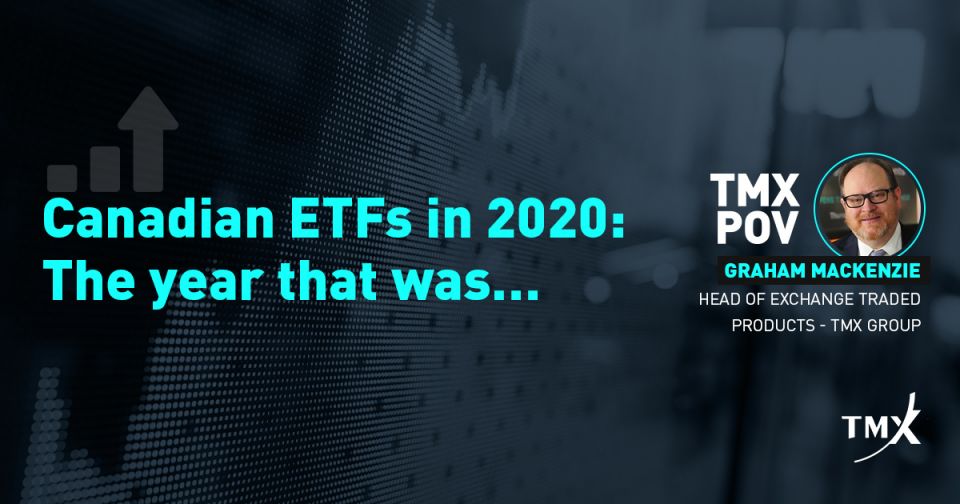TMX POV - Canadian ETFs in 2020 - The year that was …

The easiest way to reflect on 2020 is to acknowledge that it is over. So much grief, fear and heartache transpired over the course of last year that we naturally just want to move on and not look back. While that is a fair perspective to take for how much of 2020 played out, on the other hand it's worth acknowledging some of the major developments in the bustling Canadian and global ETF industry.
In the lead up to 2020, there was much discussion within the industry on how to recognize not one but two significant milestones happening that year. In early March, the ETF industry gathered to celebrate the 30th anniversary of the world's first ETF listing on Toronto Stock Exchange (TSX). It was a joyous event that marked the financial innovation that came out of Canada. Eight months later, amidst lockdowns, we celebrated with a lot less fanfare the 20th anniversary of the world's first fixed income ETF also listed on TSX. Interestingly enough, celebrating the two milestones in the same year led to some debate over which product launch had a more significant impact on investing and the capital markets.
When taking a look back at the year, the Canadian ETF industry started off at a feverish pace much like how it finished 2019 by setting records. From a record 22 new ETFs listed on TSX in January to a record initial listing size of over $1 billion with the Horizons S&P/TSX Capped Composite Index ETF (TSX: HXCN) in February, 2020 was off to a blistering start until the severity of what was happening in the world around us fully settled in.
While markets gyrated and volatility picked up in late February, it really wasn't until early March that we grasped the imminent danger we were in for. Markets moved in a sequence of free falls followed by rapid surges. For years, ETF naysayers have pushed a fallacy that the ETF structure couldn't withstand the onslaught of volatile markets. This rhetoric obviously ignored that ETFs had survived previous market challenges, like the Asian currency crisis in 1997 and the financial crisis of 2008-2009.
The spring of March 2020 could not have been a better test for the ETF structure and markets. To say ETFs didn't pass the test would be inaccurate. While corporate and high yield bond markets grinded to a halt, ETFs around the world that were tracking these markets continued to trade and gave investors access to them. Early in the mornings when equity futures markets were frozen in limit down halts, ETFs tracking the same indices as the futures continued to trade and became the proxies for global markets. ETFs were not just trading like they should be, but in several cases ETFs became the Market.
The ideology that ETFs are a fad or a house of cards waiting to fall were all rightfully proven wrong. If anything, ETFs' resilience to difficult markets exposed potential shortcomings for end of day net asset value (NAV) pricing and trading of mutual funds. While ETFs were able to reflect and trade at market prices, many mutual funds with exposure to corporates and other high yield bonds were forced to rely on stale prices causing a mis-match between their NAV and market prices. This type of price disconnect made long-term holders of these funds susceptible to wealth destruction when other investors exited the funds at values set by stale prices.
As the year progressed and we settled into the virtual world, market volatility abated and ETF business trekked ahead. While there were a few initial delays in new product launches, the quick pace that kicked off the year had returned. By the end of September, with a full quarter to go, TSX had listed more new ETFs in a single year than ever before. A record 126 new ETFs were listed on TSX in 2020.
National Bank Financial's ETF research team reported a record $41 billion in net new money went into ETFs in 2020. With $23.6 billion in net mutual fund sales according to The Investment Funds Institute of Canada at the end of November it is likely that Canadian ETFs will eclipse mutual funds for the fifth time in 2020. ETF assets under management (AUM) listed on TSX were $250B at the end of December 2020, which is a 24% growth from where it was a year earlier. The spike in volatility in late February 2020 through early spring contributed to a record 84% increase in the value of ETFs traded on the TSX.
The focus on sustainable and ESG related products also continues to grow with now 14 fund providers in Canada offering ETFs that lend themselves to the conscious investor.
While much of what is written related to 2020 is deservingly somber, there were some bright spots along the way. ETF investors can bask in knowing that the vehicle they've chosen to ride the wave should survive and has proven once again it can withstand tremulous markets. It's far too early to predict what kind of year 2021 will end up being for ETFs but if history continues to repeat itself, then expect to see plenty of new records and a few new innovative products.
Copyright © 2020 TSX Inc. All rights reserved. This information is provided for information purposes only. Neither TMX Group Limited nor any of its affiliated companies guarantees the completeness of the information contained in this article, and we are not responsible for any errors or omissions in or your use of, or reliance on, the information. The views, opinions and advice provided in this document reflect those of the individual author. This article is not intended to provide legal, accounting, tax, investment, financial or other advice and should not be relied upon for such advice. The information provided is not an invitation to purchase securities listed on Toronto Stock Exchange and/or TSX Venture Exchange. TMX Group and its affiliated companies do not endorse or recommend any securities referenced in this article.


